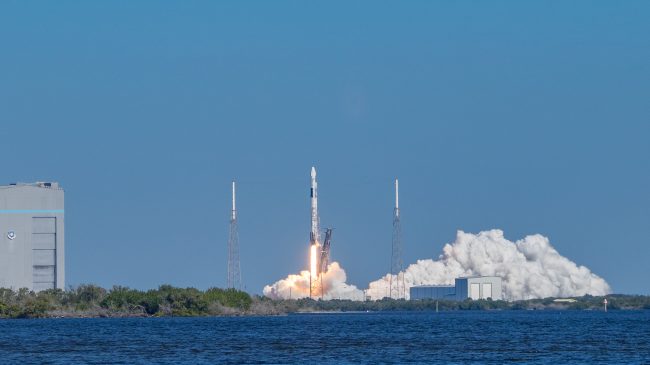Recently, two space launch vehicles made the major news. One failed a key test, while the other achieved a remarkable milestone. The difference in the two points to a turning point for space travel and exploration.
The failure took place on Jan. 16 in Alabama, where NASA’s huge Space Launch System (SLS) rocket’s first stage propulsion system began a long-awaited eight-minute test firing. But after little more than a minute, the test was abruptly ended for safety reasons, due to what was reported as a “major component failure” in Engine 4.
NASA says it hopes to run another test this month. If figuring out what went wrong and fixing it takes much longer it would almost certainly mean that the first actual SLS launch will not take place this year, as planned. And, if that happens, there’s a very likely possiblility that the system’s use for a manned flight to the moon in 2024 will not happen by that date.
Meanwhile, four days later, on Jan. 20, SpaceX launched yet another satellite launch using its workhorse Falcon 9 rocket. It successfully put another 60 SpaceX Starlink satellites into orbit, part of an eventual constellation of 12,000 that will bring broadband internet access to rural areas and developing countries worldwide. This was the eighth launch for this particular Falcon 9’s first stage, which was once again recovered by landing safely on one of the company’s drone ships.
The contrast between these two launch vehicles is profound and points the way toward increased, and lower-cost, access to space.
The SLS (admittedly much larger than Falcon 9) is a traditional throw-away rocket. It has consumed $17.5 billion of NASA funds in its 10-year development and is years late and billions of dollars over budget. When the design was developed, a key selling point was that it would save money by taking advantage of existing hardware. It would use a modified version of the Space Shuttle’s solid-rocket boosters; moreover, it would use actual left-over RS-25 main engines from the shuttle. It was one of those 30-year-old engine designs that failed on the test stand last week.
In contrast, SpaceX designed Falcon 9 with all-new technology and hardware, starting with a much smaller prototype, Falcon 1, and doing numerous test launches to fine-tune Falcon 9’s design and operation. From the get-go, Falcon 9 was designed with a reusable first stage, the largest and most-vital part of the rocket. Its much larger sister craft, Falcon Heavy, likewise has a reusable first stage, made up of Falcon 9 first stages.
NASA has worked cooperatively with SpaceX and other companies to develop private launch vehicles to resupply the International Space Station with both cargo (SpaceX and Orbital ATK) and passengers (SpaceX and Boeing). NASA engineers and program managers marveled at the unprecedented low cost of SpaceX vehicles. They developed a comparison of what it would have cost the agency to develop Falcon 9 using its traditional procurement approach versus what SpaceX actually spent. The first version found that NASA’s traditional approach would have cost $4 billion, compared with $1.7 billion for SpaceX. A later version, using a somewhat different definition of costs, found that it would have cost NASA $1.4 billion versus SpaceX’s $443 million.
The hugely costly and non-reusable SLS was not NASA’s idea. After the then-new Obama administration pulled the plug on an earlier traditional big booster, powerful members of Congress, led by Sen. Richard Shelby (R-AL), pushed for what became SLS, with the “cost-saving” idea of using left-over shuttle technology.
Critics quickly renamed SLS as the Senate Launch System. SLS backers routinely cut back NASA’s budget for privately-contracted launch vehicles to resupply the Space Station, evidently seeing what a threat they could be if they demonstrated dramatically lower costs than traditional procurement.
The wisest course for NASA now would be to pull the plug on SLS. Both SpaceX and Blue Origin are developing much larger launch vehicles that could provide an alternative way of sending astronauts to the moon. Neither will be ready by 2024, but neither, it appears, will SLS if it is continued.
The Biden administration should return to the Obama administration’s shift away from traditional cost-plus procurement and toward buying services from innovative space-launch companies. Just-retired NASA Administrator Jim Bridenstine opened up portions of the planned moon mission to innovative private providers. The new team at NASA has building blocks in place that could be expanded to include private-sector launches.
With the Democratic gains in the Senate, it is also possible SLS may have lost critical political support. Sen. Shelby will no longer chair the Senate Appropriations Committee. And some GOP House members from Alabama have lost clout due to supporting misguided efforts to overturn the 2020 presidential election results. So the politics of space may have changed enough to support canceling SLS. There is no shame in refusing to pour more money into a loser; all it takes is a dose of courage.

